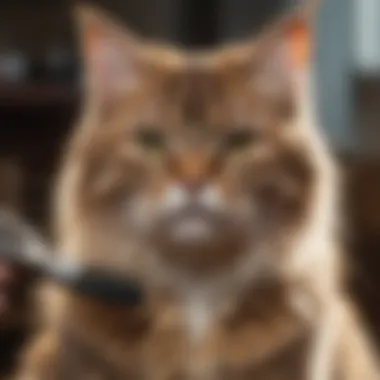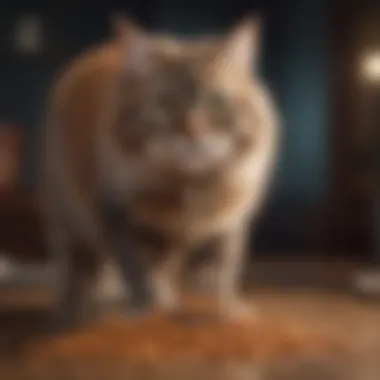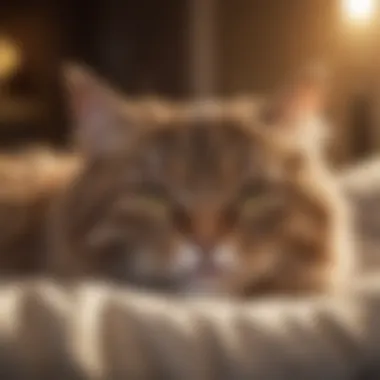Natural Home Remedies to Reduce Cat Hairballs


Intro
Cats are beloved companions, often bringing joy and comfort to their owners. However, they can also present unique challenges, one of which is the common issue of hairballs. Hairballs occur when cats groom themselves and ingest too much fur, leading to digestion issues. This can cause discomfort for the pet and concern for the owner. Thankfully, there are effective home remedies to alleviate hairballs, empowering cat owners to manage this issue effectively. In this article, we will explore practical solutions that encompass dietary changes, grooming techniques, and additional insights into maintaining the overall well-being of your feline friend.
Pet Care and Grooming
Importance of Regular Care
Regular care is essential to the health of cats. Not only does it promote healthy fur and skin, but it also helps to reduce hairball formation. By committing to a routine that includes brushing and checking for mats or tangles, cat owners can significantly minimize the amount of loose hair that may end up in the cat's stomach.
Grooming Techniques by Pet Type
Grooming techniques can vary based on a cat's coat type. For short-haired breeds like the American Shorthair, a simple brush once a week may suffice. Longer-haired breeds, such as Persians or Maine Coons, require more frequent grooming sessions. A slicker brush can effectively remove loose hair and help in reducing hairballs.
Tools and Products Recommendations
Investing in the right tools can enhance grooming effectiveness. Recommended tools include:
- Slicker brush: Great for removing loose fur.
- Furminator: Effective for deep grooming in long-haired breeds.
- Rubber grooming gloves: Ideal for short-haired cats to capture loose hair while petting.
Seasonal Care Tips
During shedding seasons, typically spring and fall, grooming should be prioritized. Regular brushing during these times can help manage excess fur, reducing the likelihood of hairballs developing. Additionally, it is important to maintain a clean environment by vacuuming frequently to remove cat hair from various surfaces.
Health and Nutrition
Understanding Pet Nutrition
A well-balanced diet is critical for overall cat health and can play a role in reducing hairball problems. High-quality cat food that is rich in protein and fiber offers essential nutrients that contribute to a healthy coat and digestive system.
Common Health Issues by Species
While hairballs are common in cats, other health issues can arise from poor grooming and nutrition. Gastrointestinal problems, allergies, and skin diseases are all potential concerns that pet owners should monitor. Regular vet check-ups can help identify these issues early on.
Preventive Care and Regular Check-Ups
Regular veterinary visits are crucial for preventive health care. They allow pet owners to maintain an awareness of their cat's health status and to adjust dietary plans based on professional advice. This proactive approach can contribute to a decrease in hairball occurrences.
Food and Dietary Advice
Incorporating high-fiber foods into a cat’s diet can aid digestion and help prevent hairballs. Consider brands like Hill's Science Diet or Royal Canin that offer specialized formulas such as hairball control. Additionally, providing ample fresh water ensures proper hydration, further supporting digestive health.
Behavioral Training
Basics of Positive Reinforcement
Training your cat to accept grooming can reduce stress for both the owner and the pet. Using positive reinforcement by offering treats during grooming sessions may help in creating a positive association.
Training Techniques Users Can Apply
Introduce grooming to your cat gradually. Start with just a few minutes of brushing each day and gradually increase the duration. Patience is key, and over time, most cats will become accustomed to the process.
Managing Behavioral Issues
If a cat resists grooming, it may be due to past bad experiences. Addressing these behavioral issues can take time. It's important to progress slowly and to avoid any sudden movements that might startle the pet.
Importance of Socialization
Socializing your cat with positive experiences can also help ease grooming sessions. Allowing them to interact in a calm environment can foster a sense of trust and reduce anxiety during grooming.
Engaging Activities and Enrichment
Fun Games to Play with Your Pet
Engaging your cat in interactive play can strengthen bonds while also promoting physical activity. Consider using feather wands or laser pointers to stimulate your pet's natural hunting instincts, which can reduce overall stress levels.
DIY Toys and Activities


Creating DIY toys from household items, such as crumpled paper balls or string toys, can provide stimulation at little cost. Regular play is important for keeping cats mentally engaged and healthy.
Importance of Mental Stimulation
Mental stimulation is also crucial for a cat’s well-being. Puzzle feeders can be great for keeping them occupied while increasing their problem-solving skills.
Outdoor Adventures and Exploration
If safe, consider allowing your cat to explore outdoors. A harness and leash can provide a new perspective for indoor cats, making them more active and engaged with their surroundings. Just be sure to supervise at all times.
Resources and Community Engagement
Recommended Books and Websites
To further understand cat care, several resources can be invaluable.
- The Cat Owner's Manual by Dr. David Brunner
- Websites like Wikipedia and Britannica provide helpful insights.
Forums and Groups for Pet Owners
Communities on platforms like Reddit can offer support and advice from fellow cat lovers.
Finding Local Services and Classes
Local pet care services often provide grooming, nutrition advice, and training classes. This can help you stay informed and better equipped to care for your pet.
Encouraging Community Sharing and Contributions
Encouraging local community engagements can foster better pet care practices. Sharing experiences and tips among pet owners can create a network of support.
Regular grooming, a balanced diet, and effective behavior management are essential in reducing the occurrence of hairballs in cats.
Understanding Hairballs in Cats
Understanding hairballs in cats is crucial for any cat owner. This phenomenon is common, yet often overlooked, despite its potential to cause discomfort or more serious health issues. Recognizing the causes and indicators of hairball formation enhances a pet owner's ability to intervene effectively.
Globally, many cats experience hairballs, particularly those with longer fur. However, short-haired breeds can also be affected. Knowing the mechanisms behind hairballs can shape how owners care for their pets. When equipped with this knowledge, owners can implement effective strategies to minimize discomfort for their cats.
What Causes Hairballs?
Hairballs form when cats groom themselves. As they lick their fur, loose hair gets swallowed. Generally, cats have rough tongues that help remove dead hair and dander. Most of the fur passes through their digestive systems, but some accumulates in the stomach. This accumulation can form a hairball over time.
Several factors contribute to the likelihood of hairball formation, including:
- Shedding Seasons: Cats typically shed more during seasonal changes, particularly in spring and fall. This increase in loose hair may lead to more hairballs.
- Grooming Habits: Cats that groom excessively or those that are stressed may develop more hairballs due to increased hair ingestion.
- Diet: Poor nutrition can affect a cat's coat health, leading to increased shedding and, by extension, hairballs. High-quality diets with sufficient nutrients are key in controlling fur loss.
- Age: Older cats may groom more meticulously, leading to higher chances of hairball formation.
Indicators of Hairball Issues
Identifying hairball issues in cats is essential for effective management. Several signs indicate a cat may be struggling with hairballs:
- Frequent Vomiting: While some hairballs are normal, if a cat frequently vomits hairballs, this could indicate a problem.
- Loss of Appetite: Discomfort from hairballs can lead to decreased interest in food.
- Constipation: Hairballs can block the gastrointestinal tract, causing this symptom.
- Coughing or Hacking: Vocalizations during attempts to expel hairballs are common.
- Excessive Grooming: If a cat is grooming more than usual, it may be ingesting more hair.
Recognizing these indicators leads to timely interventions that can improve the cat’s health and overall quality of life. By understanding both the causes and implications of hairballs, cat owners can take proactive steps to alleviate this concern.
Impact of Hairballs on Cat Health
Understanding the impact of hairballs on cat health is essential for responsible pet ownership. Hairballs, or trichobezoars, are not merely cosmetic nuisances; they can lead to discomfort and serious health issues. Recognizing how hairballs affect your cat's well-being can guide you in taking necessary preventive measures.
Physical Discomfort and Symptoms
Hairballs can cause considerable physical discomfort in cats. When a hairball forms, it can obstruct the gastrointestinal tract, leading to various symptoms. Cats may exhibit signs such as:
- Vomiting: A common symptom, vomiting may occur as the cat attempts to expel the hairball.
- Coughing: Some cats may cough or retch instead of or in addition to vomiting. This can be alarming to witness.
- Lethargy: A cat struggling with a hairball might appear less active or excited about playtime.
- Loss of Appetite: If a cat feels discomfort, they may refuse to eat, which can lead to further health concerns.
Frequent vomiting, especially if it happens more than once or twice a week, is a clear indicator that your cat might be dealing with persistent hairballs. Ignoring these signs can lead to a more severe condition, so take note of any unusual behavior.
Potential Gastrointestinal Complications


If hairballs are allowed to persist, they can lead to significant gastrointestinal complications.
When a hairball obstructs the flow of the digestive system, it can cause:
- Blockages: This is the most serious concern. A complete blockage can be life-threatening and often requires surgical intervention.
- Inflammation: The presence of a hairball can irritate the stomach lining, leading to gastritis. Symptoms may include diarrhea or additional vomiting.
- Intestinal Motility Issues: A chronic hairball issue can disrupt normal intestinal motility, causing discomfort and potential long-term digestive problems.
It's crucial to monitor your cat for signs of distress that may indicate a more serious condition related to hairballs. A visit to the veterinarian may be necessary if you observe these symptoms.
Dietary Adjustments for Hairball Prevention
Dietary adjustments play a vital role in preventing hairballs in cats. A cat’s diet influences its overall health and can significantly impact hairball formation. By focusing on specific nutritional elements, cat owners can reduce the frequency of hairballs and improve their pet’s digestion.
High-Fiber Diets
High-fiber diets are essential in minimizing hairball formation. Fiber helps in moving the ingested hair through the gastrointestinal tract. Increasing fiber can come from various sources, including specific cat food formulations or supplementary foods. For example, psyllium husk and bran can be effective additions to a cat's diet. Incorporating fibrous vegetables, such as green beans and peas, can provide natural sources of fiber. The right balance of fiber can facilitate smoother digestion and a healthier gastrointestinal system.
Hydration and Its Importance
Hydration plays a crucial role in the overall wellness of a cat and is directly linked to hairball formation. Cats often do not drink enough water, which can lead to dehydration and consequently impacted hair in their systems. Ensuring cats are well-hydrated can help in the digestion process and reduce hairball issues. Offering wet cat food or ensuring fresh water is always available can promote better hydration. A cat fountain may encourage more water intake due to the moving water, often favored by felines. Proper hydration supports overall digestion and keeps the hair moving through the intestines, minimizing the likelihood of hairballs.
Commercial Hairball Control Foods
Commercial hairball control foods are specifically designed to reduce hairball issues in cats. These foods often contain a mix of fiber sources that assist in hairball management. Many brands, such as Hill's Science Diet, Royal Canin, and Purina, offer formulas that target hairball prevention. When choosing these foods, look for options that list high-quality ingredients and avoid fillers. Regularly incorporating hairball control food into your cat’s diet can contribute to fewer hairball incidents and better overall health.
Consideration is key. Always consult with a veterinarian before making significant changes to your cat’s diet. They can provide personalized recommendations based on your cat’s specific needs and health condition.
Natural Remedies to Reduce Hairballs
Managing hairballs in cats is crucial for maintaining their overall health. Natural remedies can offer an effective approach to alleviate the discomfort and discomfort associated with hairballs. These remedies not only reduce hairball formation but also contribute to a cat's general well-being. By integrating these solutions into your cat care routine, you foster healthier grooming habits and improve the digestive function of your pet.
Olive Oil: A Natural Laxative
Olive oil serves as a natural laxative, helping to lubricate the digestive tract. This promotes smoother passage of hairballs through the gastrointestinal system. When given in moderation, olive oil can help ease discomfort caused by hairballs without risking harmful side effects common to over-the-counter medications.
To introduce olive oil to your cat's diet, follow these steps:
- ** Use a small amount**: Start with half a teaspoon, mixing it into their regular food. Observe how your cat reacts.
- Monitor for changes: Be vigilant for any symptoms of an upset stomach or changes in behavior.
As a result, your cat may enjoy the flavor while also benefiting from better digestion, reducing hairball formation over time.
Pumpkin as a Gastrointestinal Aid
Pumpkin is another powerful ally against hairballs. It is rich in fiber, which aids digestion and helps to move fur through the intestines. The high fiber content in both pure canned pumpkin and fresh pumpkin flesh promotes a healthy gut, allowing cats to pass hairballs more easily.
When incorporating pumpkin into your cat diet:
- Select plain pumpkin: Avoid pumpkin pie filling as it contains sugars and spices harmful to cats.
- Share in moderation: A teaspoon of pumpkin mixed into their meals can have positive effects, but always adjust based on their individual needs.
- Monitor their stool: Ensuring that your cat maintains a regular bowel routine will indicate effectiveness.
Overall, pumpkin can help mitigate the discomfort caused by hairballs and is a safe addition to your cat's diet.
Coconut Oil for Hairball Relief
Coconut oil is lauded for various health benefits and hairball relief is one of them. It contains medium-chain fatty acids, which can aid in digestion and lubricate the gut lining. Regular intake may help in reducing the frequency of hairball occurrence for your cat.
To use coconut oil effectively:
- Start slow: Introduce coconut oil in small quantities, like half a teaspoon mixed into food.
- Observe reaction: Watch for any allergic reactions or changes in digestion.
- Adjust dosage: Depending on your cat's size and response, you may increase it gradually.
By implementing coconut oil into your cat's diet, you can provide an additional layer of support against hairball formation, helping to keep your feline friend comfortable and healthy.
It is essential to remember that while natural remedies can be highly effective, they should complement, not replace, regular veterinary care.
Grooming Techniques to Minimize Hairballs
Effective grooming is essential for managing hairballs in cats. Regular grooming not only keeps a cat's coat healthy but also plays a crucial role in minimizing the amount of loose hair that can be ingested. When cats groom themselves, they can swallow these loose hairs, leading to hairballs. Thus, implementing a consistent grooming routine is key. A well-groomed cat is less likely to suffer from hairball-related issues.
Regular Brushing Routines


Establishing a regular brushing routine is one of the first steps cat owners should take in tackling the hairball problem. This practice helps to remove loose hair before it can be ingested. Most cats enjoy being brushed, and this can become a positive bonding experience between the pet and the owner. The brushing frequency may depend on the cat's coat type:
- Short-haired breeds: A weekly brush works well.
- Long-haired breeds: Daily brushing is recommended to prevent matting and hair accumulation.
Using a gentle brush or comb can prevent skin irritation, which some cats may experience. An effective brushing routine not only reduces shedding but also allows for the inspection of the skin and coat for any abnormalities.
De-Shedding Tools: Effective Use
In addition to regular brushes, de-shedding tools can effectively help manage shedding and minimize hairballs. These tools, such as rubber grooming gloves or specialized de-shedding brushes, are designed to remove undercoat fur and trapped hair. Here are some key points regarding their use:
- Choose the right tool: Ensure the de-shedding tool is appropriate for your cat's hair type and length.
- Gentle in mind: Use gentle strokes to avoid skin irritation.
- Establish a routine: Incorporate de-shedding sessions into your regular grooming schedule.
Proper use of de-shedding tools can lead to a noticeable reduction in shedding. This creates a healthier environment for both the cat and the owner. Moreover, less loose hair can contribute to a decrease in hairballs, ultimately supporting the cat's health and well-being.
"Regular grooming routines and effective use of de-shedding tools are crucial in supporting your cat's overall health and minimizing hairball formation."
By prioritizing these grooming techniques, cat owners can alleviate one of the common concerns associated with pet ownership, making it more enjoyable for both the pet and the caregiver.
Behavioral Modifications to Support Hairball Management
Managing hairballs in cats involves more than just dietary changes and grooming routines. Behavioral modifications play a significant role in addressing this common concern. By understanding how to influence your cat's habits, you can create an environment that supports better hairball management. This section discusses the importance of behavior adjustments, focusing on hydration and playfulness.
Encouraging Hydration
Hydration is crucial for a cat’s overall health, but it is particularly important for minimizing hairball formation. Cats often do not drink enough water, which can lead to dehydrated fur and more shedding. This leads to more hairballs. You can encourage your cat to drink more water through several methods:
- Water Bowls: Use wide, shallow bowls to make drinking easier.
- Water Fountains: Many cats are attracted to flowing water, encouraging them to drink more.
- Flavoring Water: Adding a small amount of low-sodium broth can make water more appealing.
- Wet Food: Including wet food in their diet can increase overall water intake.
By ensuring that your cat stays properly hydrated, you can help reduce the risk of hairballs, improve digestion, and promote a healthier coat.
Promoting Active Play
Physical activity is essential for cats, not just for their overall health but also for reducing the incidence of hairballs. Active play helps to manage weight, keeps the body functioning, and reduces stress. Furthermore, when cats engage in regular exercise, there is less likelihood of excessive grooming, which can lead to hairballs. Consider these tips to encourage more play:
- Interactive Toys: Use feather wands, laser pointers, or toys that move on their own.
- Structured Playtime: Set aside dedicated time each day for play sessions with your cat to stimulate their natural hunting instincts.
- Climbing Structures: Provide cat trees or shelves that allow for climbing and jumping which can contribute to their physical activity.
Incorporating these behavioral modifications into your pet care routine can lead to a healthier and happier cat, reducing the discomfort caused by hairballs. By actively promoting hydration and play, you support your cat’s overall wellbeing.
When to Consult a Veterinarian
Managing hairballs in cats often involves home remedies and preventive measures, but there are times when cat owners need to recognize when professional help is essential. Understanding when to consult a veterinarian can be critical for ensuring your cat’s health and comfort. A veterinarian can offer diagnosis and treatment beyond what home remedies can provide.
Certain signs may indicate a more serious condition requiring veterinary attention. Recognizing these signs early can prevent complications and make a significant difference in your cat’s recovery process. Cats can be quite resilient, but underlying health issues can hide behind the common problem of hairballs.
Moreover, cats with frequent hairballs may be struggling with more than just excessive grooming or hair ingestion. It is vital to be attentive and responsive to your feline’s health needs.
Signs of Serious Health Issues
When observing your cat's behavior and health, keep an eye out for several concerning signs:
- Persistent Vomiting: If your cat is vomiting more than once in a day, especially if there is a failure to pass hairballs, this could be a sign of a blockage or something more serious.
- Loss of Appetite: A lack of interest in food can signify underlying health problems requiring careful evaluation.
- Lethargy: If your active cat suddenly becomes fatigued, it could be indicating distress.
- Abdominal Pain: If your cat seems uncomfortable, especially when touched, it could be a matter for your veterinarian.
- Unusual Behavior: Any sudden changes in behavior, such as hiding away or excessive vocalization, can be a red flag.
- Dehydration: Signs of dehydration, such as dry gums and excessive thirst, should not be ignored.
It's crucial to differentiate between normal hairball formation and serious symptoms. Sudden or severe changes could indicate a condition that warrants immediate veterinary care.
Recognizing these signs promptly and taking action can impact your cat’s health significantly. If any of these symptoms present themselves, it is advisable to consult with your veterinarian to rule out serious health issues. Your awareness and action are vital in providing your cat with a healthy, comfortable life.
Culmination
In addressing the ongoing concern of hairballs in cats, it is essential to synthesize the insights and methods discussed throughout this article. Focused efforts to understand and mitigate hairball formation not only enhance the quality of life for our feline friends but also empower owners to take proactive measures in their care.
Prioritizing a multi-faceted approach is crucial. Dietary adjustments, such as incorporating high-fiber foods, are fundamental in this regard. This ensures that cats receive the necessary nutrients while reducing hairball development. Further, grooming practices such as regular brushing are instrumental in minimizing loose hair that can contribute to this issue.
Moreover, utilizing natural remedies like olive oil and pumpkin provides supplementary options that promote a healthy gastrointestinal tract. This offers relief and comfort to cats suffering from hairballs, reflecting the importance of holistic care in pet ownership.
As we conclude, do not overlook the behavioral aspects of managing hairballs. Encouraging adequate hydration and promoting active play are often overlooked elements that can lead to substantial benefits. Overall, being attentive to these various dimensions not only aids in hairball management but also leads to a healthier, happier pet.
Effective management of hairballs requires consistent attention to diet, grooming, and behavior.
Summary of Best Practices
To summarize the best practices for alleviating cat hairballs, consider the following key points:
- Implement a High-Fiber Diet: Foods rich in fiber can aid digestion and prevent hair from accumulating in the stomach.
- Maintain Proper Hydration: Ensure that your cat has constant access to fresh water, which supports gastrointestinal health.
- Regular Grooming: Brush your cat frequently to reduce the amount of loose hair and minimize hairballs.
- Utilize Natural Remedies: Incorporate options like olive oil, pumpkin, or coconut oil to promote easier passage of hair through the digestive system.
- Encourage Playfulness: Active cats tend to groom themselves less obsessively, leading to a reduction in hairball formation.
- Consult a Veterinarian if Necessary: If hairballs persist or cause significant discomfort, do not hesitate to seek professional advice.
Embrace these practices for a more effective strategy in managing hairballs in cats, contributing to their overall health and well-being.















